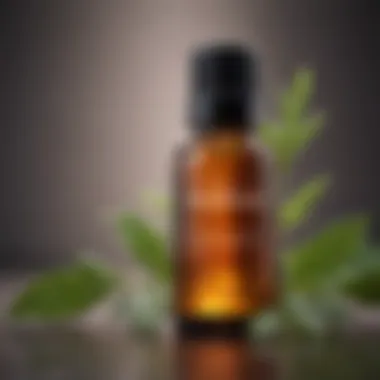Top Essential Oils to Lighten Dark Spots


Intro
Dark spots, often a result of hyperpigmentation or skin aging, can be an ongoing concern for many individuals. As people increasingly seek natural remedies, essential oils emerge as a multi-functional option. They not only hold potential for skin rejuvenation but also possess a rich history in skincare practices. This article will delve into the best essential oils tailored to combat dark spots, offering insights into their properties, effective usage methods, and the latest trends in cosmetic applications.
Key Trends
Overview of Current Fashion Trends
The modern beauty industry is witnessing a shift toward natural, holistic approaches to skincare. Essential oils have gained popularity, especially among consumers who prioritize clean and cruelty-free products. These oils are not only celebrated for their aromatic benefits but also their efficacy in addressing skin imperfections, including dark spots. Popular brands now include essential oils in their formulations, acknowledging their role in promoting skin health.
Popular Beauty Trends
Natural ingredients are increasingly favored in formulations aimed at reducing pigmentation. For instance, brands like doTERRA and Young Living produce high-quality essential oils widely recognized for their skin-brightening properties. This trend speaks to a broader movement towards sustainability and holistic health, where consumers are more educated about ingredient sourcing and product efficacy. The integration of essential oils into daily routines is growing, appealing to a diverse audience seeking both beauty and wellness benefits.
Beauty Tips and Tutorials
Understanding Skincare Routines for Different Skin Types
Different skin types require tailored approaches to effectively address dark spots. For oily skin, tea tree oil can be beneficial; its antibacterial properties help prevent breakouts and reduce inflammation. For dry skin, lavender oil is worth considering because it can soothe the skin and promote healing. Recognizing the unique needs of each skin type will enhance the effectiveness of these essential oils.
Step-by-Step Application Method
- Patch Test: Always perform a patch test to avoid allergic reactions. Apply a small amount of diluted essential oil to a discreet area and observe for any adverse reactions over 24 hours.
- Dilution: Mix essential oils with carrier oils like jojoba or almond oil. For instance, a typical dilution ratio is 5 drops of essential oil per 1 tablespoon of carrier oil.
- Application: Use clean fingers or a cotton pad to apply the mixture to dark spots. Gently massage it into the skin to promote absorption.
- Frequency: Apply daily for optimal results, preferably at night, as some oils can increase sun sensitivity.
"Effective skincare begins with understanding your skin type and choosing the right ingredients. Essential oils are not a one-size-fits-all solution."
Sustainable Practices
Understanding Sustainable Beauty
The pursuit of sustainability is becoming integral to modern beauty. Essential oils are often more environmentally friendly than synthetic ingredients. By opting for ethically sourced essential oils, consumers contribute to sustainable agriculture practices, as many plants used for oils require fewer resources compared to conventional farming.
Tips for Sustainable Beauty
- Choose brands that prioritize ethical sourcing and sustainability.
- Look for organic certifications on the essential oils you purchase.
- Support local producers who adopt eco-friendly practices in their extraction methods.
In summary, addressing dark spots requires a multidimensional approach. Essential oils can play an essential role, and understanding their benefits and how to use them properly can lead to significant improvements in skin appearance. This exploration will further assist enthusiasts in integrating essential oils into their skincare routines effectively.
Understanding Dark Spots
Understanding dark spots is crucial for anyone interested in skincare, particularly those looking to combat issues related to hyperpigmentation. Dark spots manifest due to various factors, making it essential to comprehend their origins, types, and underlying mechanisms. This knowledge allows individuals to make informed choices about their skincare products and routines. Moreover, it empowers them to implement effective treatments, ensuring healthier and more even skin tone.
Definition and Causes
Dark spots, also known as hyperpigmentation, occur when an excess of melanin, the pigment responsible for skin color, is produced. This can happen due to several reasons:
- Sun Exposure: The most common cause is prolonged exposure to the sun. UV rays stimulate melanin production as a protective measure, resulting in brown spots over time.
- Hormonal Changes: Factors such as pregnancy or hormonal therapies can trigger melasma, a form of hyperpigmentation that often appears on the face.
- Skin Inflammation: Conditions such as acne or eczema can also lead to post-inflammatory hyperpigmentation.
- Aging: With age, skin's ability to regenerate decreases, leading to the appearance of age spots.
Types of Dark Spots
Understanding the various types of dark spots is necessary for effective treatment:
Sun Spots
Sun spots, or solar lentigines, develop primarily on skin exposed to sunlight. These spots are characterized by small, flat areas that range in color from light brown to dark brown. They are particularly common among people with fair skin who have spent significant time in the sun without protection. The main benefit of addressing sun spots is that they are often treatable through various methods, including topical treatments and professional procedures. Addressing sun spots can significantly enhance the overall appearance of the skin. However, they are also a reminder of sun damage, highlighting the IMPORTANCE of sun protection.
Age Spots
Age spots, similar in appearance to sun spots, are typically associated with aging skin. These spots often arise in sun-exposed areas like the face, hands, and shoulders. They are usually harmless and vary in size, but many people seek to reduce their appearance for cosmetic reasons. The key characteristic of age spots is that they often signify accumulated sun damage over the years. While they might seem cosmetic, they can serve as an indicator of skin health, reminding individuals to be diligent about skincare and protection.


Post-Inflammatory Hyperpigmentation
Post-inflammatory hyperpigmentation occurs after a skin injury or inflammation, such as cuts, burns, or acne. The characteristic feature of these dark spots is their association with the healing process, where melanin is deposited in areas of trauma. This type of hyperpigmentation can be particularly challenging, as it may persist long after the initial injury has healed. For many, identifying and treating post-inflammatory hyperpigmentation is critical for achieving an even skin tone. It highlights the importance of gentle skincare practices, as aggressive treatments can exacerbate the issue.
The Role of Melanin
Melanin plays a significant role in determining skin color and protecting against UV radiation. When the skin is subjected to various stressors, melanin can be produced in excess, leading to dark spots. It is vital to understand that while melanin serves a protective function, overproduction can result in uneven skin tone. Addressing the factors contributing to increased melanin production can help mitigate the occurrence of dark spots and promote healthier skin overall.
These discussions on dark spots set the stage for exploring natural remedies, specifically essential oils, which may help to reduce their appearance. Understanding these aspects will guide readers toward the best practices for addressing dark spots in their skincare routines.
What Are Essential Oils?
Essential oils are concentrated plant extracts that capture the natural aroma and beneficial properties of the plant from which they are derived. They play an important role in skincare routines, particularly for addressing skin imperfections like dark spots caused by aging or hyperpigmentation. Understanding essential oils is crucial for those seeking effective natural solutions for enhancing their skin health.
Definition and Extraction Methods
Essential oils are volatile components extracted from various parts of plants, such as leaves, flowers, roots, and bark. The extraction methods are varied, with distillation and cold pressing being the most common.
- Distillation: This method involves steaming plant materials, allowing the steam to carry the essential oil into a condenser where it cools and separates. This is particularly common for oils like lavender and rosemary.
- Cold Pressing: Usually used for citrus oils, this method mechanically presses the plant skins to release their oils without the application of heat. This helps preserve the natural qualities of the oil.
These extraction methods ensure that the oils retain their potency and therapeutic properties, making them effective for various applications.
How They Function in Skincare
Essential oils boast numerous benefits for skincare due to their anti-inflammatory, antimicrobial, and antioxidant properties. They can be integrated into skincare products or used directly with proper dilution.
Some of the key functions of essential oils in skincare include:
- Promoting Skin Regeneration: Many essential oils help in stimulating skin cell turnover, which can reduce the appearance of dark spots.
- Soothing Irritated Skin: Oils like chamomile and lavender are known to calm inflammation and redness, providing relief for sensitive skin.
- Balancing Oil Production: Certain oils, such as tea tree and geranium, can regulate sebum production, making them beneficial for both oily and dry skin types.
- Enhancing Absorption of Other Ingredients: Essential oils can increase skin permeability, allowing other beneficial compounds in skincare products to penetrate more deeply and effectively.
Incorporating essential oils into a skincare regimen can lead to a more holistic approach to achieving radiant and even-toned skin.
Best Essential Oils for Dark Spots
When it comes to addressing dark spots, essential oils can play a significant role in skincare routines. These natural compounds not only carry therapeutic properties but also offer various skin benefits, including reducing hyperpigmentation. This part of the article aims to highlight why essential oils are valuable tools in the fight against dark spots.
Essential oils can facilitate skin regeneration and provide a gentle, holistic approach to skincare. Their potency lies in their concentrated plant extracts, which can offer brightening effects, enhance skin tone, and promote healing. However, it's critical to choose the right oils, as not all essential oils offer the same benefits.
Here are some key aspects to consider when using essential oils for dark spots:
- Natural Ingredients: Many essential oils contain antioxidants that can help combat oxidative stress, a contributing factor to skin discoloration.
- Anti-inflammatory Properties: Some oils possess anti-inflammatory effects that can soothe the skin, making them suitable for those with hyperpigmentation due to skin irritation.
- Individual Skin Types: Not all essential oils suit every skin type. It's essential to select oils based on your skin’s specific needs.
In this section, we will explore several essential oils known for their efficacy in addressing dark spots. Each oil has unique properties and benefits that make them suitable for different skincare needs.
Tea Tree Oil
Tea tree oil is well known for its antiseptic and anti-inflammatory properties. This oil is often used for acne treatment but can also help reduce the appearance of dark spots, especially those caused by post-inflammatory hyperpigmentation.
Tea tree oil can work to inhibit melanin production, helping to lighten these spots over time. However, it is essential to dilute tea tree oil with a carrier oil due to its strong nature.
Lavender Oil
Lavender oil is celebrated for its calming scent and is often used in aromatherapy. Beyond its soothing properties, it also aids in skincare. Lavender oil has anti-inflammatory and antioxidant properties, making it useful in reducing dark spots caused by sun exposure and aging.
Additionally, it can promote skin rejuvenation and improve overall skin tone. Its gentle nature makes it suitable for most skin types, but patch testing is recommended.
Lemon Oil
Lemon oil is a potent essential oil known for its brightening effects on the skin. It can help in fading dark spots due to its high vitamin C content. However, it is crucial to use it with caution, as lemon oil can induce photosensitivity.
It should ideally be used in the evening and always diluted before application. Regular use can lead to noticeably lighter spots and a more even skin tone.


Frankincense Oil
Frankincense oil is renowned for its ability to promote skin health. It can help in reducing the appearance of dark spots due to its cellular regeneration properties. This oil is particularly beneficial for mature skin, as it can improve elasticity and reduce signs of aging.
Its calming properties further enhance its application, as it nourishes both the skin and the senses.
Geranium Oil
Geranium oil is another essential oil with properties that benefit skin health. It can help in balancing skin tone and improving circulation, effectively addressing dark spots. Its astringent nature also helps tighten the skin, which may reduce the appearance of spots over time.
Geranium oil is typically well-tolerated, but individuals should still consider patch testing before a full application.
Carrot Seed Oil
Carrot seed oil is packed with antioxidants and vitamins, making it a valuable choice for those looking to combat dark spots. This oil rejuvenates the skin and promotes cell renewal. Its nourshing properties help heal damaged skin, including areas affected by hyperpigmentation.
Rosehip Oil
Rosehip oil, rich in essential fatty acids, provides both moisturizing and regenerative properties. It is highly regarded for its capability to improve skin texture and tone. Regular application may help diminish dark spots and support an overall radiant complexion.
The use of essential oils in skincare, especially for addressing dark spots, requires careful consideration. Understanding each oil’s properties can lead to effective treatment. Readers should proceed with caution, always patch testing unfamiliar oils and considering their skin's sensitivities.
Integrating Essential Oils into Your Skincare Routine
Integrating essential oils into your skincare routine is an essential step for those seeking to address dark spots on their skin. Essential oils are a natural remedy that promise various skin benefits, especially for pigmentation issues. In this part, we will explore the best practices for utilizing these oils, their effects, and the various methods to incorporate them into daily regimens.
Dilution and Application Techniques
When using essential oils, dilution is a critical factor to consider. Essential oils are highly concentrated and can cause skin irritations if applied directly. The general rule is to dilute them with a carrier oil before use. Common carrier oils include jojoba, coconut, and sweet almond oil. A typical dilution ratio is one to two drops of essential oil for every teaspoon of carrier oil.
Application methods vary with the desired outcome. For addressing dark spots, targeted application with a cotton swab allows for precision. For broader areas, using fingertips to massage the mixture gently into the skin promotes absorption. Always ensure that your skin is clean before application for better effectiveness.
Frequency and Duration of Use
Understanding how often to use essential oils is essential for achieving optimal results without causing damage to your skin. Most skincare experts recommend starting with a frequency of two to three times a week. This allows your skin to acclimate to the oils and prevents overexposure. Once you learn how your skin reacts, you can gradually increase the frequency if desired.
Duration also plays a role. Most essential oils should be left on the skin for at least 30 minutes, but overnight applications can yield better results for some individuals. Observe how your skin responds, and adjust the routine accordingly.
Layering with Other Skincare Products
Layering essential oils with other skincare products can enhance their efficacy. It is advisable to apply essential oils after cleansing and toning your skin but before heavier creams or moisturizers. This allows the oils to penetrate deeply without being obstructed by other products.
Consider the order of application. Here’s a simple layering guide:
- Cleanser: Clean your face thoroughly.
- Toner: Apply toner to balance your skin.
- Essential Oils: Apply the diluted essential oil mixture.
- Moisturizer: Use a moisturizer to lock in hydration and nutrients.
By following these steps, you can effectively integrate essential oils into your skincare regime. While essential oils offer promising benefits, it is essential to do thorough research and consult with a skincare professional if needed. Their magical potential unfolds with proper understanding and meticulous application.
Safety Considerations
Understanding safety considerations is crucial when incorporating essential oils into your skincare regimen. While essential oils can offer numerous benefits, they can also pose risks if not used correctly. This section will explore different factors that everyone should know to ensure a safe and effective experience with these natural remedies.
Allergic Reactions and Skin Sensitivity
Allergic reactions to essential oils can occur, and it's vital to be aware of how your skin may respond. Sensitive skin types may react negatively to certain oils, leading to redness, irritation, or other unwanted effects. To minimize these risks, individuals should be cautious when selecting oils.
- Always consult a dermatologist if unsure about using a particular oil.
- Certain oils, like tea tree and lemon, may provoke reactions in some people.
To ensure safety, consider keeping a diary of any reactions after application. This record can guide your choices in the future.
Patch Testing Essential Oils


Conducting a patch test before using essential oils more broadly is an important step. This process helps identify potential allergic reactions without exposing a large area of skin. The method is straightforward:
- Dilute a few drops of the essential oil with a carrier oil, like jojoba or coconut oil.
- Apply the mixture to a small area of skin, typically on the inner forearm.
- Wait 24 hours to observe any reaction.
If redness or itching occurs during this period, discontinue use immediately. This test is a practical method to prevent unwanted side effects.
Avoiding Photosensitivity
Certain essential oils can increase skin sensitivity to sunlight, known as photosensitivity. Citrus oils, like lemon and bergamot, are notorious for this effect. Using these oils in the daytime can risk sunburn or pigmentation issues.
To avoid complications, follow these guidelines:
- Use photosensitive essential oils at night.
- Always apply sunscreen when using such oils during the day.
- Consider consulting with a skincare professional if you are uncertain about specific oils and their impact on your skin.
Important Note: Awareness and caution can help ensure that the benefits of essential oils outweigh any potential risks. Prioritizing safety will lead to a more enjoyable and rewarding skincare journey.
Alternative Remedies for Dark Spots
Dark spots can be persistent and frustrating, often impacting self-esteem and skin confidence. While essential oils provide a natural approach to treating these spots, it is also essential to explore alternative remedies. Combining various methods can lead to more effective results. This section discusses natural exfoliants, chemical treatments, and professional options that can complement the use of essential oils.
Natural Exfoliants
Natural exfoliants play a significant role in skin care, especially when targeting dark spots. These remedies help remove dead skin cells and promote the growth of new ones, leading to a more even skin tone. Common natural exfoliants include:
- Sugar Scrubs: They provide gentle exfoliation and can enhance circulation, which may help reduce dark spots.
- Coffee Grounds: Rich in antioxidants, they can brighten the skin and improve its texture.
- Baking Soda: This mild abrasive not only exfoliates but also has antibacterial properties.
When using natural exfoliants, it is important to avoid over-exfoliating the skin, as this can cause irritation and worsen the appearance of dark spots. A frequency of one to two times per week is generally recommended.
Chemical Treatments
Chemical treatments offer a more targeted alternative for addressing dark spots through the use of acids and compounds. Popular options include:
- Alpha Hydroxy Acids (AHAs): Such as glycolic and lactic acids, these exfoliants promote cell turnover, thereby helping to fade dark spots over time.
- Beta Hydroxy Acids (BHAs): Salicylic acid is known for its ability to penetrate pores, making it effective for those with oily skin types.
- Hydroquinone: This topical agent reduces melanin production, making it a popular choice for lightening dark spots.
It is crucial to consult a dermatologist before starting chemical treatments, as some may lead to adverse effects or require careful handling.
Professional Treatments
For those seeking quicker results, professional treatments are available that can target dark spots more effectively. Options include:
- Laser Therapy: Techniques such as fractional laser therapy can stimulate skin renewal and significantly reduce the appearance of dark spots.
- Chemical Peels: Performed by professionals, they use stronger concentrations of acids to exfoliate the skin deeply.
- Microdermabrasion: This treatment exfoliates the superficial layers of the skin, promoting a smoother and more uniform texture.
While these professional options can be effective, they usually involve higher costs and potential downtime. Therefore, a thorough discussion with a skin care professional is recommended to weigh the benefits and risks.
Incorporating alternative remedies for dark spots into a comprehensive skin care approach can increase the effectiveness of essential oils. Understanding each option allows for informed decisions tailored to individual skin needs.
Closure
In wrapping up this exploration of the best essential oils for dark spots, it is crucial to highlight several key points regarding their application and effectiveness. This article not only sheds light on individual oils, such as Tea Tree, Lavender, and Lemon oil, but also emphasizes their unique properties that aid in addressing hyperpigmentation.
Importance of Essential Oils in Skin Care
Essential oils can serve as a beneficial addition to skincare routines. These natural compounds are derived from plants and contain concentrated amounts of active ingredients. Using them can provide various skin benefits including reducing the appearance of dark spots, enhancing skin radiance, and improving overall skin texture.
Benefits of Addressing Dark Spots
Dark spots can be a source of concern for many. They often signify aging, sun damage, or other skin issues. Addressing these through essential oils can offer a more natural alternative to harsher chemical treatments. Moreover, regular use of these oils may lead not only to lighter spots but also to healthier skin over time.
Considerations for Use
While essential oils can be effective, it is vital to approach their use with care. Proper dilution and testing for skin sensitivity are essential steps that should never be overlooked. Those with sensitive skin or allergies must exercise caution and consult with a professional before beginning any new skincare regimen.
An effective skincare routine combines the use of essential oils with other treatments and a focus on overall skin health. By considering both the benefits and necessary precautions, individuals can better approach the reduction of dark spots, leading towards a more radiant complexion.
"Nature itself is the best chemist; harnessing it wisely can yield great results for skin health."
Ultimately, knowledge is power. Understanding how to incorporate essential oils thoughtfully into your routine can lead to significant improvements in skin health. Taking time to explore these benefits contributes not just to aesthetics, but also to the general well-being of the skin.



